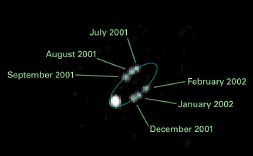

|
Документ взят из кэша поисковой машины. Адрес
оригинального документа
: http://www.stsci.edu/~inr/thisweek1/thisweek015.html
Дата изменения: Fri Jun 8 23:36:04 2007 Дата индексирования: Tue Oct 2 13:58:15 2012 Кодировка: |


| Program Number | Principal Investigator | Program Title | Links |
| 10793 | Avishay Gal-Yam, California Institute of Technology | A Survey for for Supernovae in Massive High-Redshift Clusters | Abstract |
| 10800 | Keith Noll, Space Telescope Science Institute | Kuiper Belt Binaries: Probes of Early Solar System Evolution | Abstract |
| 10802 | Adam Riess, Space Telescope Science Institute | SHOES-Supernovae, HO, for the Equation of State of Dark energy | Abstract |
| 10829 | Paul Martini, The Ohio State University | Secular Evolution at the End of the Hubble Sequence | Abstract |
| 10833 | Bradley Peterson, The Ohio State University Research Foundation | Host Galaxies of Reverberation Mapped AGNs | Abstract |
| 10842 | Kem Cook, Lawrence Livermore National Laboratory | A Cepheid Distance to the Coma Cluster | Abstract |
| 10844 | Kris Davidson, University of Minnesota - Twin Cities | Following Eta Carinae's Change of State | Abstract |
| 10849 | Stanimir Metchev, University of California - Los Angeles | Imaging Scattered Light from Debris Disks Discovered by the Spitzer Space Telescope around 21 Sun-like Star | Abstract |
| 10861 | David Carter, Liverpool John Moores University | An ACS Treasury Survey of the Coma cluster of galaxies | Abstract |
| 10862 | John Clarke, Boston University | Comprehensive Auroral Imaging of Jupiter and Saturn during the International Heliophysical Year | Abstract |
| 10877 | Weidong Li, University of California - Berkeley | A Snapshot Survey of the Sites of Recent, Nearby Supernovae | Abstract |
| 10878 | John O'Meara, The Pennsylvania State University | An ACS Prism Snapshot Survey for z~2 Lyman Limit Systems | Abstract |
| 10886 | Adam Bolton, Smithsonian Institution Astrophysical Observatory | The Sloan Lens ACS Survey: Towards 100 New Strong Lenses | Abstract |
| 10890 | Arjun Dey, National Optical Astronomy Observatories | Morphologies of the Most Extreme High-Redshift Mid-IR-Luminous Galaxies | Abstract |
| 10899 | Matthew Malkan, University of California - Los Angeles | Identifying z>7 galaxies from J dropouts | Abstract |
| 10904 | David Thilker, The Johns Hopkins University | Star formation in extended UV disk (XUV-disk) galaxies | Abstract |
| 10905 | R. Tully, University of Hawaii | The Dynamic State of the Dwarf Galaxy Rich Canes Venatici I Region | Abstract |
| 10906 | Sylvain Veilleux, University of Maryland | The Fundamental Plane of Massive Gas-Rich Mergers: II. The QUEST QSOs | Abstract |
| 10918 | Wendy Freedman, Carnegie Institution of Washington | Reducing Systematic Errors on the Hubble Constant: Metallicity Calibration of the Cepheid PL Relation | Abstract |
| 10931 | Edmund Nelan, Space Telescope Science Institute | Dynamical Masses and Radii of Four White Dwarf Stars | Abstract |
| 10998 | Peter McCullough, Space Telescope Science Institute | Exoplanet XO-1b: light curve and parallax | Abstract |
GO 10793: A Survey for Supernovae in Massive High-Redshift Clusters
GO 10800: Kuiper Belt Binaries: Probes of Early Solar System Evolution
 Composite HST image of the Kuiper Belt binary, WW31
Composite HST image of the Kuiper Belt binary, WW31
|
The Kuiper Belt consists of icy planetoids that orbit the Sun within a broad band stretching from Neptune's orbit (~30 AU) to distance sof ~50 AU from the Sun (see David Jewitt's Kuiper Belt page for details). Over 500 KBOs are currently known out of a population of perhaps 70,000 objects with diameters exceeding 100 km. Approximately 2% of the known KBOs are binary (including Pluto, one of the largest known KBOs, regardless of whether one considers it a planet or not). This is a surprisingly high fraction, given the difficulties involved in forming such systems and the relative ease with which they can be disrupted. It remains unclear whether these systems formed from single KBOs (through collisions or 3-body interactions) as the Kuiper Belt and the Solar System have evolved, or whether they represent the final tail of an initial (much larger) population of primordial binaries. This proposal aims to use ACS/HRC images of known KBOs toidentify new binary systems. |
GO 10861 An ACS Treasury Survey of the Coma cluster of galaxies
GO 10886: The Sloan Lens ACS Survey: Towards 100 New Strong Lenses